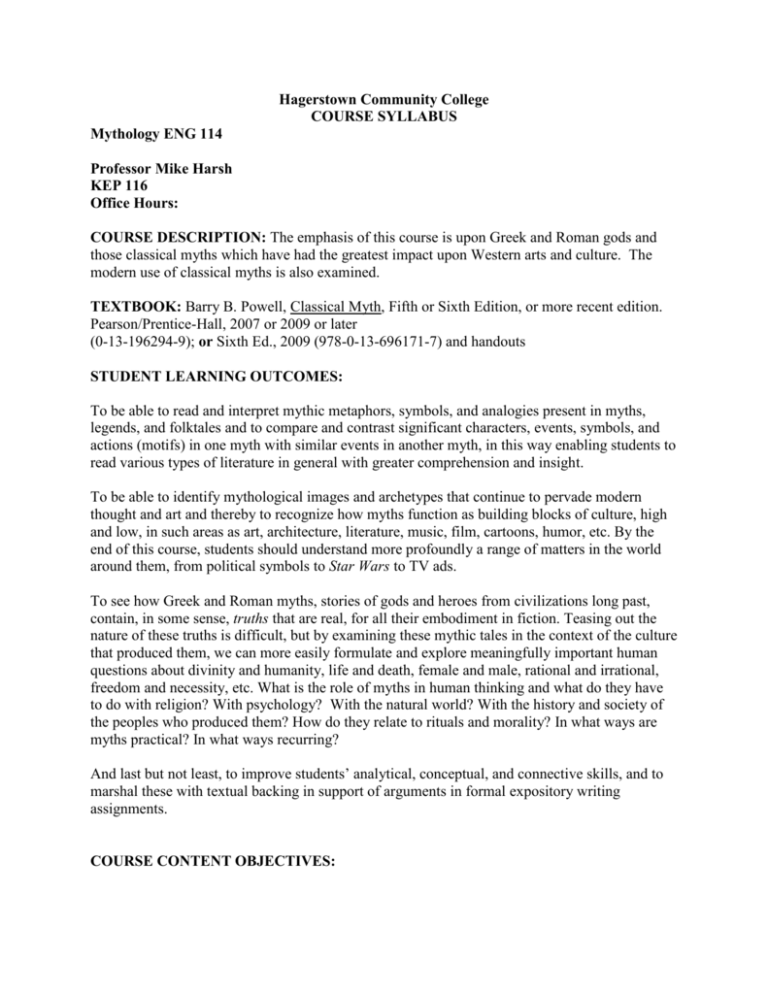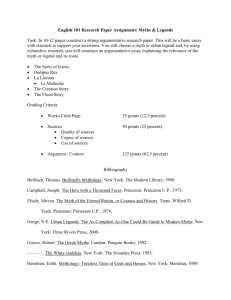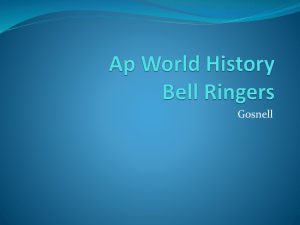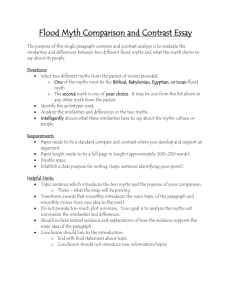
Hagerstown Community College
COURSE SYLLABUS
Mythology ENG 114
Professor Mike Harsh
KEP 116
Office Hours:
COURSE DESCRIPTION: The emphasis of this course is upon Greek and Roman gods and
those classical myths which have had the greatest impact upon Western arts and culture. The
modern use of classical myths is also examined.
TEXTBOOK: Barry B. Powell, Classical Myth, Fifth or Sixth Edition, or more recent edition.
Pearson/Prentice-Hall, 2007 or 2009 or later
(0-13-196294-9); or Sixth Ed., 2009 (978-0-13-696171-7) and handouts
STUDENT LEARNING OUTCOMES:
To be able to read and interpret mythic metaphors, symbols, and analogies present in myths,
legends, and folktales and to compare and contrast significant characters, events, symbols, and
actions (motifs) in one myth with similar events in another myth, in this way enabling students to
read various types of literature in general with greater comprehension and insight.
To be able to identify mythological images and archetypes that continue to pervade modern
thought and art and thereby to recognize how myths function as building blocks of culture, high
and low, in such areas as art, architecture, literature, music, film, cartoons, humor, etc. By the
end of this course, students should understand more profoundly a range of matters in the world
around them, from political symbols to Star Wars to TV ads.
To see how Greek and Roman myths, stories of gods and heroes from civilizations long past,
contain, in some sense, truths that are real, for all their embodiment in fiction. Teasing out the
nature of these truths is difficult, but by examining these mythic tales in the context of the culture
that produced them, we can more easily formulate and explore meaningfully important human
questions about divinity and humanity, life and death, female and male, rational and irrational,
freedom and necessity, etc. What is the role of myths in human thinking and what do they have
to do with religion? With psychology? With the natural world? With the history and society of
the peoples who produced them? How do they relate to rituals and morality? In what ways are
myths practical? In what ways recurring?
And last but not least, to improve students’ analytical, conceptual, and connective skills, and to
marshal these with textual backing in support of arguments in formal expository writing
assignments.
COURSE CONTENT OBJECTIVES:
1. To know the most basic definition of "myth," different categories (divine, legend, folktale),
functions, and constituent parts (plot, conflict).
2. To familiarize students with the major gods and goddesses of ancient Greece and Rome, their
spheres of influence, their names, character, their relationships, and their exploits as well as the
principal Greek and Roman heroes and legends, essential for understanding these ancient
societies and indispensable for appreciating the far-reaching influence their thinking has had on
Western civilization.
3. To examine the Greeks' attitude towards the relationship between the human and divine
spheres and how the myths and legends of the Greeks relate to their society and religion through
history, religious festivals (e.g., the Olympics), and the importance of competition, reason,
moderation, pride.
4. To examine the nature and social function of myth by studying a number of different ancient
and modern theories which attempt to account for this universal phenomenon (e.g., allegorical,
neoplatonic, feminist, psychoanalytic).
5. To become familiar with several examples of major ancient Greek and Roman literary works
(for example, those of Homer, Hesiod, Ovid, Vergil) that preserve the Greek myths for us.
6. To gain some familiarity with the visual arts which depict the myths and legends of Ancient
Greece and Rome, both from antiquity and in subsequent eras, as well as examples of literary
works based on such myth.
7. Wherever possible, to note some correspondences between the classical myths and those of
other cultures (Hindu, Native American, Germanic, Celtic, Egyptian, African).
8. To deal with three kinds of questions: reading, interpretive, and critical:
a) Reading questions ask about facts: subject, content, plot, the literal story-line.
b) Interpretive questions ask about thinking: theme, metaphors, symbolism, form.
c) Critical questions ask about evaluating and judging: taste, period, history, politics, and
ethics. (Answers depend on the evidence and reasoning you can bring to back up your
opinions and usually contain phrases like "do you think" or "why do you suppose.")
9. To lead students not toward or away from any position of belief but to enable one to see what
the subject means, not to accept or reject it. Some students may resist being led towards belief,
while others may resist being led away from it. This course encourages open-mindedness for
individual beliefs while also exploring the many ways of reading and understanding religious
stories.
10. To have, as one professor has stated, “a jolly good time learning some ripping yarns from
antiquity that continue to be crowd-pleasers two and a half millennia later,” and which continue
to supply the “endless and ever-adaptive arsenal” of European arts, literature and thought.
Total Hours of Coursework:
For most classes, students should expect to do at least 2 hours of coursework outside of class for
each hour of in-class coursework.
In-class instruction, including any exams or inclass essays
Assigned readings and short reflection
assignments
37.5 hours
One documented essay amounting to roughly 4
or 5 pages of writing and research in the final
draft, not to include worked cited pages
TOTAL MINIMUM TIME AN AVERAGE
STUDENT SHOULD EXPECT TO SPEND
ON THIS CLASS
15 hours for prewriting, writing, research,
documentation, and revision
60 hours
112.5 HOURS
To earn one academic credit at HCC, students are required to complete a minimum of 37.5 clock
hours (45 fifty-minute “academic” hours) of coursework per semester. Those hours of
coursework may be completed through a combination of hours within the classroom and hours
outside the classroom. Certain courses may require more than the 37.5 minimum hours of
coursework per credit.
For most classes, students should expect to do at least 2 hours of coursework outside of class for
each hour of in-class coursework.
ASSESSMENT PROCEDURES:
Your final grade will be determined by:
1/3
attendance and active participation in all projects
1/3
essay and short answer written assignments
1/3
final research project
Note: Instructor may make changes in the syllabus with prior notice. Stay alert.
COURSE POLICIES:
1.
All work turned in by students must be their own and consistent with the honor code
currently in place at the College. Plagiarism will result in an F and an Honor Code
violation. A plagiarized research project will result in an F for the course.
2.
Class is required. You will be allowed the standard two cuts. Any absences beyond that
number will be reflected in the grade for the course. (See college attendance policy in the
HCC catalog.) Plan on two hours of study for each in-class hour.
4.
Snow-days: Class will meet if the College is open. (See College website.)
Services for Students with Special Needs:
Students who have special needs are encouraged to identify themselves to the coordinator of
special student services as early as possible. Reasonable accommodations based on current
documentation are provided to qualified students.
TOPICAL OUTLINE:
Preliminary discussion: kinds of myths, interpretations of myth, examples, definitions
Myths of Creation (Hesiod’s Theogony)
Zeus, Hera and the Twelve Olympians:
Legends and Heroic Myths:
Perseus
Heracles
Theseus
Oedipus
Odysseus
The Trojan War
Jason and the Argonauts
Topic(s) and Readings 5th edition (6th edition)
Week
1:
Chs. 1 and 2: What is a myth? 2-13; Divine: Phaethon, 84 (82); Tithonus: 85 (82);
Legend: The Judgment of Paris, 540-42 (514-16); The Trojan Horse, 571 (543), The Fall
of Troy; Laookon, 574 (546); death of Priam, 576-77 (548-549); Folktale: Polyphemus,
596-606 (566-576); Sirens, 608 (577).
2:
Ch. 24: Theories of Myth, 674-99 (642-667); types of myth continued
3:
Ch. 4:
4:
Ch. 5: Origin of mortals, Pandora; the five races/ages, the flood
5:
Ch. 6: Zeus and Hera
6:
Ch. 7: Male deities: Poseidon, Apollo, Hephaestus, Ares, Hermes, Pan,
7:
Ch. 8: Female deities: Hestia, Aphrodite (Adonis); Artemis, Athena
8:
Ch. 9: Demeter and Persephone
9:
Ch. 10: Dionysus and Ch. 11: The Underworld, the sinners, Orpheus,
10:
“Black Orpheus”
11:
Ch. 13: Perseus “Clash of the Titans”
12:
Ch. 15: Theseus, the Amazons, the Minotaur, Daedalus and
Icarus, death of Theseus
Myths of creation
13:
Ch. 17: Oedipus
14:
Ch. 14: Heracles, The Twelve Labors, Death
15:
The Hero – group project
16:
Final Exam meeting – Project Presentations









